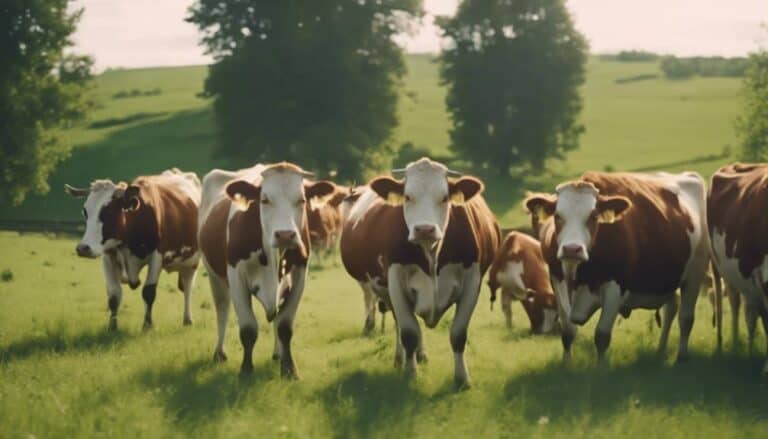GPS technology has revolutionized precision herding, offering real-time monitoring and data-driven insights into livestock tracking. With GPS collars recording animal positions at preset intervals, herders can efficiently manage herds and optimize grazing patterns. This technology enables proactive decision-making and swift responses to anomalies, enhancing overall herd safety. By utilizing precise monitoring and detailed data on animal movements, GPS technology transforms traditional herding methods into efficient, data-informed practices. Dive deeper into how GPS is transforming livestock tracking for improved efficiency and sustainable practices.
Key Takeaways
- GPS technology optimizes livestock tracking and grazing strategies.
- Real-time data aids in precise livestock management.
- Historical data analysis enhances future behavior predictions.
- Revolutionizes herd management with data-driven decisions.
- Ensures excellent care and sustainability for livestock welfare.
The Role of GPS Telemetry in Livestock Tracking
GPS telemetry plays an essential role in livestock tracking by enabling remote monitoring and precise data collection of animal movement patterns.
Livestock GPS collars are equipped with technology that records the geographic positions of animals at predefined intervals, allowing for detailed tracking and analysis of their movements.
This level of precision is vital for effective herd management, as it provides valuable insights into grazing patterns, territorial behavior, and overall herd dynamics.
Real-Time Monitoring Benefits for Herders
Real-time monitoring of livestock through GPS tracking technology revolutionizes herders' ability to instantly locate, track, and manage their animals with unparalleled efficiency. GPS tracking provides herders with real-time location data, enabling precise livestock management. By utilizing tracking devices, herders can monitor their livestock continuously, receiving updates on their movements promptly. This immediate access to information allows for proactive decision-making and swift responses to any anomalies in the animals' behavior. Additionally, the use of GPS-enabled geofencing ensures the safety of the livestock by establishing virtual boundaries and alerting herders to any breaches instantly.
The benefits of real-time monitoring extend to optimizing grazing patterns and overall herd management, leading to improved efficiency in livestock operations. The data collected through GPS tracking systems empowers herders to make informed decisions that enhance their precision livestock practices. With the ability to track their animals' movements accurately and react promptly to any issues, herders can elevate their livestock management to new levels of effectiveness.
Enhanced Herding Practices With GPS Technology
Utilizing advanced GPS technology enhances herding practices by providing precise monitoring of livestock location and movements, optimizing grazing patterns, and ensuring effective herd safety management.
Farmers can now access real-time data on animal positions, allowing for immediate intervention in case of straying or potential threats. GPS has become a valuable tool for farmers, offering open access to essential information that was once challenging to obtain.
By tracking animal positions accurately, farmers can strategically plan grazing patterns, leading to improved resource utilization and increased milk production. This level of precision in monitoring livestock movements revolutionizes traditional herding methods, enabling farmers to make data-driven decisions promptly.
Additionally, GPS technology facilitates proactive herd safety measures, minimizing risks and promoting overall herd health. Enhanced herding practices with GPS technology not only streamline operations but also enhance the efficiency and productivity of livestock management.
Improving Rangeland Management Efficiency
Enhancing rangeland management efficiency involves leveraging precision technology to optimize livestock tracking and grazing strategies for sustainable practices. By using GPS for tracking cattle on rangelands, farmers can benefit from detailed information on their animals' movements and behaviors. This data allows for real-time monitoring, enabling quick adjustments to grazing patterns to prevent overgrazing and guarantee efficient land use. The benefits of GPS extend to helping farmers make informed decisions about when to rotate livestock to different areas for grazing, maximizing the land's productivity.
Moreover, GPS technology assists in conserving battery life on tracking devices by efficiently transmitting data and optimizing power usage. This feature is essential for continuous monitoring without interruptions. By utilizing GPS for rangeland management, farmers can achieve improved efficiency in livestock herding, leading to sustainable practices and increased productivity. The detailed insights provided by GPS tracking enable better decision-making, ultimately contributing to the overall health of the rangelands and the well-being of the livestock.
Data-Driven Decision Making in Precision Herding
Precision herding strategies, enabled by GPS technology, revolutionize livestock tracking through data-driven decision making. By harnessing the power of the Global Positioning System (GPS), real-time location data provides essential insights for optimizing livestock management.
This technology allows farmers to monitor the movements of their herds with unparalleled precision, leading to more informed decisions regarding grazing patterns, resource allocation, and overall herd health. With GPS tracking, farmers can analyze historical data trends to predict future behavior, enabling proactive adjustments to their herding strategies.
The ability to access detailed information on individual animal locations and behaviors enhances herd management practices, ultimately improving efficiency and productivity. Additionally, the utilization of data-driven decision making in precision herding not only benefits farmers but also contributes to the overall welfare of the livestock by ensuring excellent care and sustainable practices.
Conclusion
To sum up, GPS technology has revolutionized livestock tracking, providing herders with real-time monitoring and enhancing herding practices. Utilizing data-driven decision-making, precision herding has become more efficient and effective, leading to improved rangeland management.
With GPS as their guiding star, herders can navigate the complexities of livestock tracking with precision and accuracy, ensuring the well-being of their animals and maximizing productivity in the field.
Embrace the power of precision herding and watch your livestock management soar to new heights.

